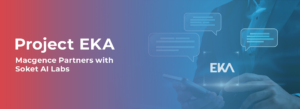A Beginner’s Guide to Natural Language Processing (NLP)
Natural Language Processing (NLP), an innovative technology capable of understanding and decoding human language, has brought significant breakthroughs in many sectors, transforming how we communicate with machines. From social media monitoring to text classification, NLP plays a crucial role by effectively processing vast amounts of unstructured data. So, let’s dive into the world of NLP and discover the power of language in the digital age.
What is Natural Language Processing (NLP) ?
Natural Language Processing (NLP) is an exceptional technological development enabling computers to understand human communication nuances accurately. With NLP implementation, machines gain proficiency in understanding both written and spoken language, allowing them to provide comprehensive descriptions, summaries, and analyses that resemble human-style writing. Therefore, it has enabled efficient interaction between users and AI products available today in our daily lives. NLP is used in various domains and applications, such as information retrieval, machine translation, speech recognition, etc.
NLP’s rising demand highlights broader accessibility & availability of quality data paired with advancements in processing power are contributing factors for its booming adaptation rate contributing significantly towards improved user experience across various platforms.
Natural Language Processing techniques
The field of Natural Language Processing involves utilising either syntax-based or semantics-based techniques. Syntax-oriented strategies work by evaluating sentence structure and grammar rules to comprehend written or verbal communication, whereas semantic methods involve deciphering meaning through an understanding of contextual clues within a text or speech sample. To understand NLP techniques comprehensively, it’s essential to examine both approaches in further depth.
Syntax-based Techniques:

- Tokenisation: This method breaks down text into smaller units called tokens. Like individual words or subword units.
- Part-of-Speech Tagging: It involves assigning grammatical tags to every word in a sentence, including nouns, verbs, adjectives, and adverbs.
- Parsing: it is the process of examining sentences’ grammatical structure, identifying word relationships, and generating parse trees that depict the syntactic framework.
- Named Entity Recognition (NER): It identifies and sorts different kinds of named entities such as person names, locations, organisations or dates.
Semantics-based Techniques:

- Word Sense Disambiguation: It aims to pinpoint the accurate meaning of ambiguous words by analysing the context, related semantics, and adjoining vocabulary.
- Semantic Role Labeling: This helps in recognising and distinguishing the role an entity plays within a sentence; these roles may include subject, object, and predicate, thereby revealing its overall semantic structure for better understanding.
- Sentiment Analysis: It helps in determining the underlying tone within a text. It analyses the text for positive, negative, or neutral emotions so that it can be accurately classified across various levels.
- Question Answering: It is a process that involves understanding and interpreting inquiries to provide accurate responses. It relies on extracting relevant information from a text corpus to deliver precise answers.
Uses of Natural Language Processing
NLP’s applications span a wide range of domains, from social media monitoring to text classification, where it excels in efficiently processing large volumes of unstructured data. Now, let’s delve deeper into some of the significant uses and applications of NLP:

- Machine translation: NLP plays a crucial role in the operation of machine translation setups that allow seamless translation across different languages. These setups rely on NLP algorithms to decipher sentence meanings and accurately produce translations.
- Text Summarization: The abundance of online data can be overwhelming for internet users seeking rapid access to crucial information. Fortunately, with advancements in Natural Language Processing (NLP), the creation of condensed versions known as “summaries” has become achievable. These summaries allow readers to save time by presenting a concise rendition that captures the essential points emphasised in a lengthier article or document.
- Speech Recognition: Speech recognition systems are made possible due to NLP techniques, enabling computers to convert spoken words into written text. This groundbreaking technology finds applications in various areas, including voice assistants, transcription services, and other impressive speech-to-text functionalities.
- Information Retrieval: The invaluable assistance of Natural Language Processing is the crucial element that enables search engines to accurately understand user queries and extract relevant information from vast amounts of text data.
Conclusion
In conclusion, Natural Language Processing (NLP) is a game-changing technology in our tech-focused era that deserves recognition and focus. The ability of computers to understand human speech through NLP has greatly improved user experiences on various platforms. By accurately capturing human expression nuances, NLP facilitates seamless communication between humans and machines, enhancing user experiences everywhere.
Down the road, the prospective advantages of NLP are quite massive, and without a doubt, NLP will become more intelligent and sophisticated as technology continues to progress rapidly.
The ultimate result? Machines that boast a greater ability than ever before when it comes to understanding human language. In practical terms, we will see more advanced chatbots and enhanced voice assistants. Beyond consumer applications, businesses are also positioned to benefit. Equipped with state-of-the-art analytical tools that leverage natural language processing, they will uncover valuable insights hidden within vast amounts of unstructured text data.
How can Macgence help?
Macgence is proud to offer top-notch training data that supports large-scale models. We provide services such as data transcription and annotation and much more, tailored to your NLP requirements. We understand the importance of ongoing maintenance for AI projects, and we’re here to offer expert advice when needed. With our expertise, we ensure high-quality ML and AI setups that deliver reliable results. Explore our resources or contact us directly to learn how Macgence can support your next project.
Frequently Asked Questions (FAQ)
Q1. What are the main applications of NLP?
The main applications of NLP are machine translation, text summarization, sentiment analysis, speech recognition, and chatbots.
Q2. Are there any ethical considerations associated with NLP?
Yes, there are ethical considerations associated with NLP. Some of these include privacy concerns, bias in language models, potential misuse of NLP technology, and the impact on job displacement.
Q3. What are the challenges faced in NLP?
Some of the challenges faced in NLP include understanding context, handling ambiguity, dealing with language variations, managing large amounts of data, and overcoming language barriers.
You Might Like
February 28, 2025
Project EKA – Driving the Future of AI in India
Spread the loveArtificial Intelligence (AI) has long been heralded as the driving force behind global technological revolutions. But what happens when AI isn’t tailored to the needs of its diverse users? Project EKA is answering that question in India. This groundbreaking initiative aims to redefine the AI landscape, bridging the gap between India’s cultural, linguistic, […]
March 7, 2025
What is Data Annotation? And How Can It Help Build Better AI?
Spread the loveIntroduction In the world of digitalised artificial intelligence (AI) and machine learning (ML), data is the core base of innovation. However, raw data alone is not sufficient to train accurate AI models. That’s why data annotation comes forward to resolve this. It is a fundamental process that helps machines to understand and interpret […]
March 6, 2025
Vertical AI Agents: Redefining Business Efficiency and Innovation
Spread the loveThe pace of industry activity is being altered by the evolution of AI technology. Its most recent advancement represents yet another level in Vertical AI systems. This is a cross discipline form of AI strategy that aims to improve automation in decision making and task optimization by heuristically solving all encompassing problems within […]
March 5, 2025
Use of Insurance Data Annotation Services for AI/ML Models
Spread the loveThe integration of artificial intelligence (AI) and machine learning (ML) is rapidly transforming the insurance industry. In order to build reliable AI/ML models, however, thorough data annotation is necessary. Insurance data annotation is a key step in enabling automated systems to read complex insurance documents, identify fraud, and optimize claim processing. If you […]


 Previous Blog
Previous Blog







